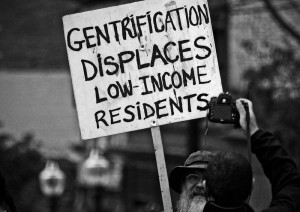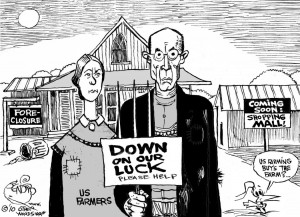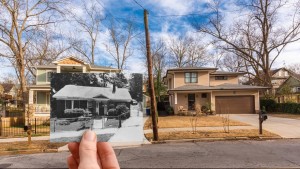
Flynn, Laura. “Gentrification.jpg” Kalw. March 27, 2016. Web. http://mediad.publicbroadcasting.net/p/kalw/files/styles/x_large/public/201506/gentrification.jpg., Last accessed April 29, 2016
Atlanta is known for many different things: musical heritage, Southern hospitality, sports teams, and of course the Hartsfield-Jackson International Airport. That is of course what lies outside of the white picket fence, what many people don’t know is what truly lies behind that picket fence. In which many people may not see or even notice what it is until they find themselves lost in midtown or downtown Atlanta. That’s when they are forced to open their eyes and unveil the truth of Atlanta in the dark. Gentrification, the merging of wealthy people into an already existing urban district, leading in to economical value increase of rent, homes, etc.. gentrification is often seen as negative since it forces poor communities to minimize by rich outsiders. Many people are unaware as to the fact that gentrification exists in their own home of Atlanta, as well as the many issues that come with the merging. Regardless of the merge we need to address the issue so that the lower income communities who live in these neighborhoods don’t end up losing their homes.

Sadler, Liberty Antonia. “Gentrification_libertyantoniasadler_metro.jpg.” October 7, 2015. Web. https://metrouk2.files.wordpress.com/2015/10/gentrification_libertyantoniasadler_metro.jpg?w=748&h=526&crop=1. Last Accessed April 29, 2016.
If you walk downtown Atlanta, depending on your social status, you will either expect one of two things; a beautiful city filled with nightlife adventures, or a dangerous place in which you would not have been walking alone in the first place. Luckily, in Atlanta you get to see both the adventure and fright of walking alone. Due to gentrification creeping its way into the city you may eventually find yourself no longer feeling the fright of walking alone in downtown Atlanta but instead finding yourself in a rich community where you’d wish you could live in. Although pretty it may sound, what happens to the people who made you want to lock your doors while you were in your car? How do you know they are genuinely malicious people?? That’s right, you don’t know; you don’t know where they wound up and you don’t know who they are as a civilian. As you lock your doors behind them, you don’t quite see the bigger picture. You often see people walking from place to place because they cannot afford to buy a car. Knowing that MANY civilians do not have enough money to buy a new car, imagine having to be one who is stripped from your house and having to find a new place to live, causing you to look for a different job as well. Pause for a second, if someone has to take public transportation or walk from place to place because they can’t afford to buy a car what makes you think they can afford to be charged higher rent and eventually have to foreclose their home because they can’t pay to live in a wealthier community. Between 2000 and 2007 Atlanta’s urban homes went from the bottom half of home price distribution to the top half by 31 percent (Carmichael). According to an article by Rodney Carmichael, Atlanta is a city made up of 54 percent of black residents in which he predicts will fall under the halfway mark due to gentrification.

otherwords.org. “American-Gothic-Bendib-1050×760.jpg.” Thru. August 9, 2015. Web. http://www.thrumag.com/wp-content/uploads/2015/08/american-gothic-bendib-1050×760.jpg, Last Accessed April 29, 2016.
Recently the Atlanta Beltline was created and since then has been adding onto the rise of gentrification. The Atlanta Beltline has caused significant amounts of issues with local residents that can not afford the increase in property taxes; students from Atlanta Public Schools have reported that the Beltline is more prioritized rather than the education for the district’s youth (The Signal). According to Solomon Fortune’s Built Environment Description of the Atlanta Beltline; she described the Beltline as hard to access for people who live in nearby apartments. Complaining that shrubs, gates, and landscapes would make it difficult for them to enter to Beltline. Fortune described this as a way of making it seems as though they don’t trim certain bushes in order to keep out the lower class neighborhoods. Which is extremely unfair seeing as though they are the neighborhoods that have to pay extra in taxes in order to even have a beltline. However, if you do go ahead and make a visit to the Beltline you will find yourself confused as to how you see streets with no one asking you for money around every corner. Recently, I went to Midtown Atlanta to see a concert at the Masquerade. The drive there was an eye opener. At first I saw nothing but old rusted up buildings and a lot of black community neighborhoods. Walking down these streets, I saw mostly African American people with nothing but everyday normal clothes. Then I turned one street and all of a sudden it felt as though we were no longer in Atlanta but somewhere in Buckhead, Georgia. Here, I saw nothing but upper-class rich city people. The only people I saw walking on these streets were people that looked like they were about to go to a fancy dinner party. Most likely they were, but even on these streets I saw an elderly white couple walking to their car, worry free. I found it oddly strange that nowhere in sight was there a person from one of the black neighboring communities, or inversely, a white person going to dinner in one of the black neighboring communities. After a while you can’t help but think is this segregation and racism in your very own city of Atlanta? No, it’s a new form of segregation that lies within the streets of Atlanta, its gentrification.

Meister, Josh. “0316_realestate_kirkwood01_jmeister_oneuseonly.jpg.” Atlanta Magazine, March 1, 2016. Web. http://www.atlantamagazine.com/wp-content/uploads/sites/12/2016/03/0316_realestate_kirkwood01_jmeister_oneuseonly.jpg. Last Accessed April 29, 2016.
Let’s look at a different neighborhood located in East Atlanta, Kirkwood. According to their own Historic Kirkwood Neighborhood website, one of their values and beliefs is “Appreciation of social and intellectual diversity”. However gentrification is vastly making its way into this neighborhood. Along with changes of buildings that used to be historic and made with a lot of sentimental emotions behind it, Kirkwood has made gentrification into a good thing, rather than a bad one. Before 1990 one percent of Kirkwood’s population were white. There is still no statistics showing what the population of Kirkwood is now, but according to the Atlanta Magazine and they’re article on “How Gentrification Really Changes a Neighborhood” by Josh Green, it is assumed that majority of population now is nonblack residents. Green states that displacement is a part of Kirkwood’s deepest roots. However, the gentrification process in Kirkwood did in fact eliminate a lot of crime rate going on at the time. As well as still keeping its historical background alive. Many changes were made in the process and a lot of old homes that had sentimental value to many of the old residents disappeared over time. Old residents who saw the crime happening in their neighborhood but stuck to it and continued to live in that neighborhood in order to see the potential changes that would come out of it. They stuck to that neighborhood to be a part of that history, as well as to see their future generations grow up in that house knowing that what once was a dangerous place to live, is now a safe environment to grow up in. Older generations that stayed put and saw the demolishment of lower-income apartments saw the good in gentrification. They saw crime rates go down while integrating new people to come into their once dangerous streets. That right there is the only good outcome of gentrification, crime leaving the streets into a safer environment for children to play with; without fear of being robbed, kidnapped, and killed. However gentrification may improve communities, it doesn’t change the fact about how they approach the situation. Instead of hiring more protection within these communities, they drive those people away. But if they drive the criminals away, where do they end up at instead? If you look at the whole picture crime rate reduced in that area alone, but did it reduce in all, or did we only move the problem elsewhere. Elsewhere, where they can afford to do crime and not be driven out. That is, if they can afford to move elsewhere, or maybe they’ll end up in the streets hoping for a miracle to come up from a rough patch.
Gentrification has either two outcomes; a bad in which you lose your home and are forced to move elsewhere, or a good in which your community is rid of negative externalities. Overall we should consider the effects on those who don’t have much of a say in the matter. When you look at it the minority doesn’t have the time to go to community meetings and share their input in the matter. There should be a better way to improve low-income families. No matter how hard we try to improve the neighborhood in which they live in; people with more money will eventually want to live in that community and eventually drive those low-income families out. This is why we should come up with different ways to integrate the good with the bad. Such as having a mixture between the two instead of just making it good all at once, in one particular location. Why not integrate everyone instead of having one perfect community and one bad community. We need a different form of gentrification in which no one gets left out and no one is forced to be driven out of their once was “home”.
For citations and more information on articles click here.
Leave a Reply